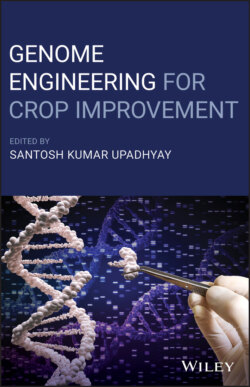Читать книгу Genome Engineering for Crop Improvement - Группа авторов - Страница 20
1.5 CRISPR‐Cpf1
ОглавлениеIntroduction of CRISPR‐Cpf1 also known as CRISPR‐Cas12a further diversified the genome engineering methods (Figure 1.2). Cpf1 is an endonuclease which belongs to the class II CRISPR family (Alok et al. 2020; Zaidi et al. 2017). It was identified from Prevotella and Francisella1, therefore named as named as Cpf1. This system become popular as it was able to fill the gaps of previous genome editing tools and can substitute the CRISPR‐Cas9 in an efficient way (Moon et al. 2018). It is smaller in size than Cas9 and required a shorter CRISPR RNA for proper functioning (Liu et al. 2017). Unlike the CRISPR/Cas9, tracrRNA is no longer necessary to process Cpf1 associated mature CRISPR RNAs (Zetsche et al. 2015). Further, in contrast to the G rich PAM at 3′ end in CRISPR Cas9, it requires a T‐rich PAM sequence at the 5′‐end to perform cleavage efficiently, which enables the targeting of AT‐rich regions in the genome. Further, Cpf1 creates staggered cuts where insertion of a DNA fragment is easily possible via HDR (Gao et al. 2017). The off‐target binding of CRIPSR‐Cpf1 is comparatively less than CRISPR‐Cas9 which could be an additional benefit (Kim et al. 2016; Kleinstiver et al. 2016; Yan et al. 2017). A number of studies showed the application of CRISPR‐Cpf1 for targeted genome editing in various eukaryotes including plants (Kim et al. 2017; Zetsche et al. 2015). It has also been used for multiple targets in the genome (Wang et al. 2017).
Figure 1.2 Comparison of various features of CRISPR‐Cpf1 (a) and CRISPR‐Cas9.
Source: Adapted from Zaidi et al. (2017) © 2017. Reproduced with the permission of Elsevier.
